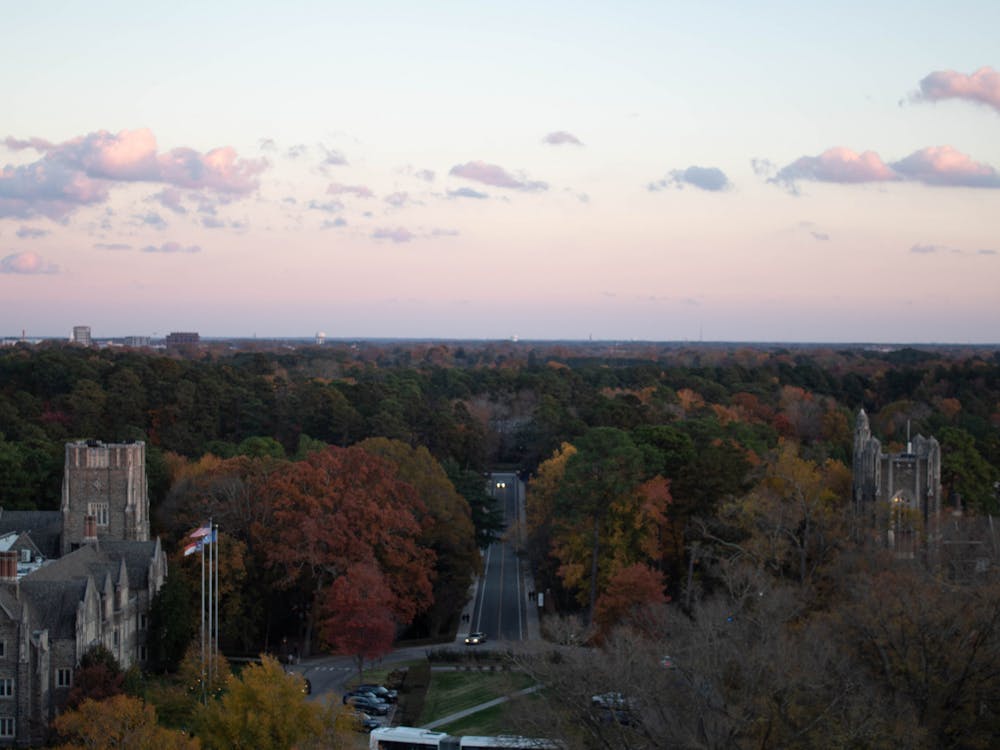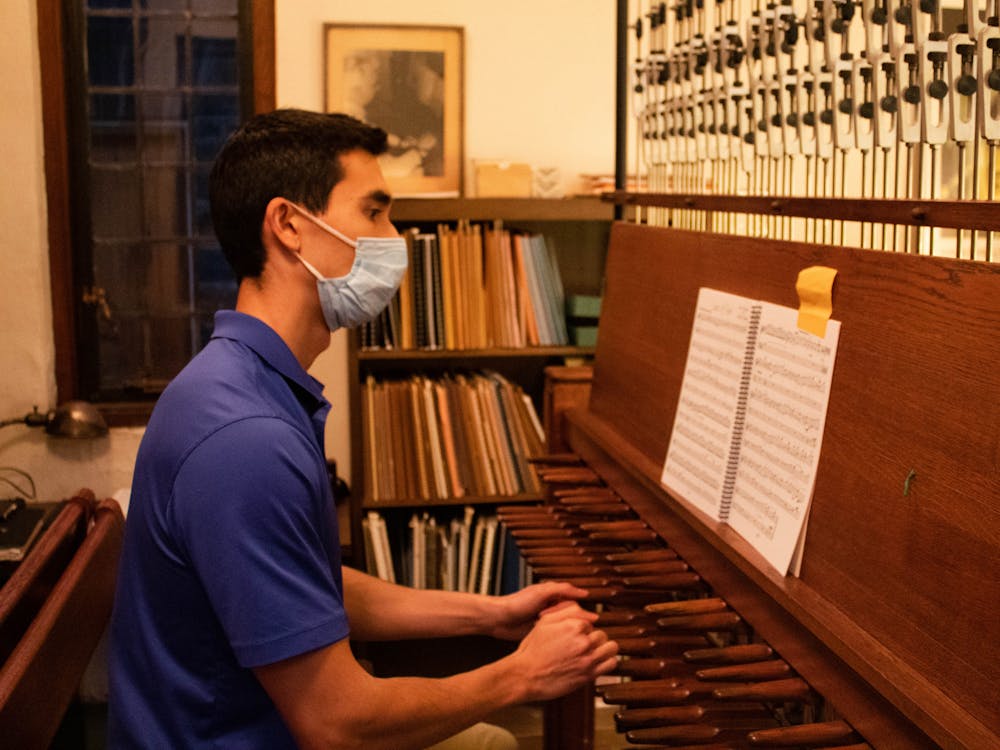Joseph Fala leans into the music as he plays. He hits wooden batons with his hands, pushes pedals with his feet and reads the sheet music in front of him, all the while swaying slowly from side to side. Above him, the bells of the Duke Chapel ring with dignity and purpose, the music audible across West Campus.
Fala, a carillonneur for the Duke Chapel, is responsible for most weekly performances of the Chapel bells, which are formally known as a carillon. He began playing the carillon when he was a graduate student at Yale University studying the organ. Now that he’s at Duke, he has taken over the duties of playing an instrument whose nine-decade history is entwined with that of the University.
***
It’s 4:55 p.m. on Thursday, Nov. 18. Fala hurries through the Chapel and enters a side door to a windowless stone room. He pulls out a key, unlocks another door and locks it behind him after he enters. He then opens the metal grate of a tiny elevator, barely large enough for three people, and slowly ascends the Chapel tower.
The elevator takes Fala to the great chamber where the bells are suspended. He steps into a small office in the middle of the space, its ceiling open so the bells are visible above.
This is Fala’s routine each weekday besides Wednesday, when his colleague Paul Bumbalough plays the carillon. Fala also plays before and after Sunday worship services.
Fala begins each 5 p.m. performance with a “snippet of a hymn that is appropriate for the Chapel,” per carillon tradition. He then plays five deep tolls to mark the hour.
After that, he varies what he plays based on the liturgical season and holidays. Fala draws from music written for the carillon as well as popular culture: classical pieces, popular hits, hymns and film soundtracks. For example, he plays the Star Wars theme on May 4.
If there is a holiday or special day approaching, Fala plans what he will play a week or so in advance.
“If it’s just an ordinary day, I come up here and take the music that day,” he said.
Fala also uses his song choices to acknowledge world events. For example, when Notre Dame Cathedral caught fire on April 15, 2019, the Chapel’s bells rang out with the French national anthem.
Fala emphasized that it is rare for universities to have a carillonneur. Other universities often have an electric or hybrid bell system, meaning the bells can ring on their own and a carillonneur isn’t necessary; for example, as a 1999 News & Observer article noted, the tower at the University of North Carolina at Chapel Hill contains a hybrid instrument.
Despite popular belief, Duke’s bells are not electronically controlled. Instead, they are completely mechanical. The carillon has 50 bells spanning four octaves, and all of them—weighing from 10.5 pounds to 10,200—are struck by clappers that Fala moves by pushing wooden batons down in his office.
“It’s purely whatever energy you put into the machine is what you get out,” Fala said.

There’s something beautiful about having a carillonneur pick the repertoire of the bells. The human element of choosing songs and playing them live is a way of “honoring events of Duke, of our community, of our nation, of the world in sound and music,” Fala said.
“It’s fun to be a part of such a long-standing Duke tradition. I think it’s special that Duke keeps someone on staff to play music,” he said. “There’s something about having a live person up there.”
***
In April 1930, then-Duke President William P. Few received a letter from Duke Endowment Chairman George G. Allen and Vice Chairman William R. Perkins.
“We desire to present to the University a carillon for installation in the tower of the church which is now under construction,” Allen and Perkins wrote.
Chief designer Julian Abele had designated space in the Chapel tower for bells, but there wasn’t funding to buy the bells themselves at the time. Allen and Perkins’ gift would fill the empty space.
“It is a beautiful gift you have made,” Few wrote Perkins in response. “The Chapel bells will in a sense be the voice of the University, and it is most appropriate that this voice should come through the two men now living who were most intimately associated with Mr. James B. Duke.”
In search of a carillon, Duke turned to the Taylor Bell Foundry of Loughborough, England. The company had cast more than 20 carillons in Europe, the United States and beyond, including many of the bells at London’s St. Paul’s Cathedral.
At the carillon’s inaugural recital in June 1932, Anton Brees played to a crowd of more than 10,000 people, according to that month’s Alumni Register. It was the first of many performances for Brees, who would go on to serve as Duke’s carillonneur until 1956.
The instrument bears the name of another carillonneur, J. Samuel Hammond, who held the post from 1968 until his retirement in 2018. Hammond was known not only for playing the bells approximately more than 15,000 times over five decades, but also for his deep faith, love for Duke and interest in the work of his friends and colleagues.
After Hammond died in February, Chapel Dean Luke Powery remembered him as an iconic Duke figure.
“He knew these luminaries, the professors people talk about from the past. If you were touching Sam, it was like you’re touching Duke history,” Powery said.
When Fala became carillonneur, he took on the tradition of playing the bells each weekday and on Sundays. A photograph of Anton Brees hangs on the wall of the room where Fala plays the carillon, a reminder of the nine decades of history behind his position.
Fala carried on playing even during the early days of the COVID-19 pandemic. The carillon’s music rang out on a nearly empty campus, a small symbol of constancy that the Chapel’s music director called a “sign of hope” in a hard time.
The bells’ music has resonated in literature, too. A photograph of the Chapel graces the cover of a collection of poems by Dan Blachly, titled “Carillons.” The second of stanza of the titular poem reads:
Above the bells and on every side
The belfry tower is open wide
It has no lattice or window pane
Protecting from the frost or rain
The fragrant wind by the meadow blows
And among the bells of the carillon flows;
The drifting snow and the biting sleet
Upon the carillon beat,
But through storm and shine their melody sweet
Floats like the song of angels down
Over the country side and town.
***

On a late afternoon in December, there is neither “drifting snow” nor “biting sleet.” It’s a mild 66 degrees. People sit alone or in small groups on the Bryan Center plaza. Some chat with friends; more work silently on computers. Finals are approaching, after all.
The bells begin to ring.
Four members of Every Nation Campus, a Christian ministry, are on the plaza for a meeting. They come each Thursday to do a variety of things, such as asking people about religion or offering to pray for them. The bells ring as they talk.
Junior AJ Smith, one of the members of Every Nation Campus, said he doesn’t pay much attention to the bells. They’re just a reminder that five o’clock has arrived.
For junior Anna McFarlane, it’s the opposite. She lives on campus and hears the bells most days, but they don’t make her think of the time. Instead, she enjoys the beauty of the music.
“I think it always sounds magical, like a blessing,” McFarlane said.
For Julia Bretz, Trinity ‘17, the bells are “classic Duke.” They’re also a reminder of the University’s Christian roots.
“They’re church bells, you know,” she said. “We forget that. They’re not just random bells.”
The bells stop ringing.
The Chapel stands silent against a darkening sky. The Plaza isn’t quiet, though. There is the low hum of students talking and laughing, walking and brushing their feet against fallen leaves—all the other sounds of life at Duke.
Editor's note: This article has been updated to reflect that North Carolina State University installed a carillon this year and does not use an electronic system. The Chronicle regrets the error.
Get The Chronicle straight to your inbox
Signup for our weekly newsletter. Cancel at any time.
Matthew Griffin was editor-in-chief of The Chronicle's 116th volume.

Paige Carlisle is a Trinity senior and a staff reporter for The Chronicle.

